Tong W. Wind Power Generation and Wind Turbine Design
Подождите немного. Документ загружается.

Tower Design and Analysis 555
[28] Verholek, M.G., Preliminary results of a fi eld experiment to characterise wind
fl ow through a vertical plane. Rep. PNL-2518, Battelle Pacifi c Northwest
Laboratory , Richland, WA 99352, 1978.
[29] Hardesty, R.M., Korrel, J.A. & Hall, F.F., Lidar measurement of wind
velocity spectra encountered by a rotating turbine blade. NOAA Technical
Memorandum , Washington DC, USA, 1981.
[30] Murtagh, P.J., Basu, B. & Broderick, B., Along wind response of wind turbine
tower with blade coupling subjected to rotationally sampled wind loading.
Engineering Structures , 27 (8), pp. 1209–1219, 2005.
[31] Murtagh, P.J., Basu, B. & Broderick, B.M., Mode acceleration approach for
rotating wind turbine blades. Proc. of the Institution of Mechanical Engineers:
Part K: Journal of Multi-body Dynamics , 218 (3), pp. 159–167, 2004.
[32] Williams, D., Dynamics loads in aeroplanes under given impulsive loads with
particular reference to landing and gust loads on a fl ying boat. Royal Aircraft
Establishment, Farnborough, UK, Reports SMR 3309 and 3316 , 1945.
[33] Craig, R.R., Structural Dynamics , John Wiley and sons: New York, 1981.
[34] Singh, M.P., Mode-acceleration based response spectrum approach for non-
classically damped structures. Soil Dynamics and Earthquake Engineering ,
5 , pp. 226–233, 1986.
[35] Akgun, M.A., A new family of mode-superposition methods for response
calculations. Journal of Sound and Vibration , 167 (2), pp. 289–302, 1993.
[36] Nigam, N.C. & Narayanan, S., Applications of Random Vibrations , Springer
Verlag: Delhi, 1994.
[37] Kaimal, J.C., Wyngaard, J.C., Izumi, Y. & Cote, O.R., Spectral characteristics
of surface-layer turbulence. Journal of the Royal Meteorological Society , 98 ,
pp. 563–589, 1972.
[38] Davenport, A.G., Gust Loading Factors. Journal of Structural Division,
ASCE , 93 (3), pp. 11–34, 1967.
[39] Velozzi, J. & Cohen, E., Gust response factors. Journal of Structural Division,
ASCE , 94 (6), pp. 1295–1313, 1968.
[40] Holmes, J.D., Along-wind response of lattice towers: part II – Aerodynamic
damping and defl ections. Engineering Structures , 18 (7), pp. 483–488, 1996.
[41] Zhou, Y. & Kareem, A., Gust loading factor: new model. Journal of Structural
Engineering, ASCE , 127 (2), pp. 168–175, 2001.
[42] Zhou, Y., Kijewski, T. & Kareem, A., Along-wind load effects on tall build-
ings: comparative study of major international codes and standards. Journal
of Structural Engineering, ASCE , 128 (6), pp. 788–796, 2002.
[43] Murtagh, P.J., Basu, B. & Broderick, B.M., Gust response factor methodol-
ogy for wind turbine tower assemblies. Journal of Structural Engineering,
ASCE , 133 (1), pp. 139–144, 2007.
[44] Crandall, S.H., First crossing probabilities of linear oscillator. Journal of
Sound and Vibration ,
12 (3), pp. 285–289, 1970.
[45] CEN (2004). Eurocode 1 Basis for design and actions on structures – part 2- 4:
actions on structures – wind actions. European Prestandard Env. 1991-2- 4,
European Committee for Standardization, Brussels , 2004.
556 Wind Power Generation and Wind Turbine Design
[46] Dueñas-Osorio, L. & Basu, B., Unavailability of wind turbines from wind
induced accelerations. Engineering Structures , 30 (4), pp. 885–893, 2008.
[47] Wright, A.D. & Balas, M.J., Design of control to attenuate loads in the con-
trols advanced wind turbine. Journal of Solar Energy Engineering, ASME ,
126 , pp. 1083–1091, 2004.
[48] Kallesøe, B.S., A low-order model for analysing effects of blade fatigue load
model. Wind Energy , 9 (5), pp. 421–436, 2006.
[49] Murtagh, P.J., Ghosh, A., Basu, B. & Broderick, B., Passive control of wind
turbine vibrations including blade/tower interaction and rotationally sampled
turbulence. Wind Energy , 11 (4), pp. 305–317, 2008.
[50] McNamara, R.J., Tuned mass dampers for buildings. Journal of the Structural
Division, ASCE , 103 (9), pp. 1785–1798, 1977.
[51] Luft, R.W., Optimal tuned mass dampers for buildings. Journal of the
Structural Division, ASCE , 105 (12), pp. 2766–2772, 1979.
[52] Gerges, R.R. & Vickrey, B.J., Wind tunnel study of the across-wind response
of a slender tower with a nonlinear tuned mass damper. Journal of Wind
Engineering and Industrial Aerodynamics , 91 (8), pp. 1069–1092, 2003.
[53] Den Hartog, J.P., Mechanical Vibrations , McGraw-Hill Book Company Inc.:
New York, 1947.
[54] Mallik, A.K., Principles of Vibration Control , Affi liated East West Press Pvt.
Ltd.: New Delhi, India, 1990.
[55] Ghosh, A. & Basu, B., A closed form optimal tuning criterion for TMD in
damped structures. Structural Control Health Monitoring , 14 , pp. 681–692,
2007.
[56] Carril, C.F., Isyumov, N. & Brasil, R., Experimental study of the wind forces
on rectangular latticed communication towers with antennas. Journal of Wind
Engineering and Industrial Aerodynamics ,, 91 , pp. 1007–1022, 2003.
[57] Gioffrè, M., Gusella, V., Materazzi, A.L. & Venanzi, I., Removable guyed
mast for mobile phone networks: load modelling and structural response.
Journal of Wind Engineering and Industrial Aerodynamics , 92 , pp. 467–475,
2004.
[58] Ruscheweyh, H., Vortex-induced vibration of a water tank tower with small
aspect ratio. Journal of Wind Engineering and Industrial Aerodynamics , 89 ,
pp. 1579–1589, 2001.
[59] Kim, Y.-M. & You, K.-P., Dynamic response of a tapered tall building to
wind loads. Journal of Wind Engineering and Industrial Aerodynamics , 90 ,
1771–1782, 2002.
[60] Cho, K.-P., Cermak, J.E., Lai, M.-L. & Nielsen, E.J., Viscoelastic damp-
ing for wind-excited motion of a fi ve-story building frame. Journal of Wind
Engineering and Industrial Aerodynamics , 77 (8), pp. 269–281, 1998.
[61] Wu, J.-C. & Pan, B.-C., Wind tunnel verifi cation of actively controlled high-
rise building in along-wind motion. Journal of Wind Engineering and Indus-
trial Aerodynamics , 90 , pp. 1933–1950, 2002.
[62] Murtagh, P.J. & Basu, B., Identifi cation of modal viscous damping ratios
for a simplifi ed wind turbine tower using Fourier and wavelet analysis.
Tower Design and Analysis 557
Proceedings of the Institution of Mechanical Engineers, Part K: Journal of
Multi-body Dynamics , 221 (4), pp. 577–589, 2007.
[63] Murtagh, P.J., Dynamic analysis of wind turbine tower assemblies, Ph.D.
thesis, University of Dublin, Trinity College Dublin, Ireland, 2004.
[64] Rogers, N., Structural dynamics of offshore wind turbines subject to extreme
wave loading. Proc. of the 20th BWEA Annual Conf. , UK, 1998.
[65] Colwell, S. & Basu, B., Tuned liquid column dampers in offshore wind tur-
bines for structural control. Engineering Structures , 31 (2), pp. 358–368,
2009.
[66] DNV, Design of Offshore Wind Turbine Structures. Offshore Standard
DNV-OS-J101, 2004.
[67] Hasselmann, K., Barnett, T.P., Bouws, E., Carlson, H., Cartwright, D.E.,
Enke, K., Ewing, J.A., Gienapp, H., Hasselmann, D.E., Kruseman, P.,
Meerburg, A., Muller, P., Olbers, D.J., Richter, K., Sell, W. & Walden, H.,
Measurement of Wind-Wave Growth and Swell Decay During the Joint
North Sea Wave Project (JONSWAP) . Deutsche Hydrogr , A8 (12), 1973.
[68] Ditlevsen, O., Stochastic model for joint wind and wave loads on offshore
structures . Structural Safety , 24 , pp. 139–163, 2002.
[69] Sarpkaya, T. & Isaacson, M., Mechanics of Wave Forces on Offshore
Structures , Reinhold, V.N.: New York, 1981.
[70] Hoffman, D. & Karst, O.J. , The theory of Rayleigh distribution and some of
its applications . Journal of Ship research , 19 (3), pp. 172–191, 1975.
[71] Colwell, S. & Basu, B., Simulation of joint wind and wave loading time
histories. Proc. of the Irish Signals and Systems Conf. , Dublin , paper no. 120,
pp. 1–5, 2006.
This page intentionally left blank
CHAPTER 17
Design of support structures for offshore
wind turbines
J. van der Tempel , N.F.B. Diepeveen , D.J. Cerda Salzmann
& W.E. de Vries
Department of Offshore Engineering, Delft University of Technology,
The Netherlands.
Offshore wind is the logical next step in the development of wind energy. With
higher wind speeds offshore and the fact that turbines can be placed out of sight,
offshore wind helps increase the amount of renewable energy signifi cantly. Off-
shore wind has been developed through pilot projects in the 1990s and has seen
commercial development over the last decade. This chapter shows the develop-
ment of offshore wind and then focuses on the design of support structures. It
briefl y describes all fundamental steps that need to be taken to come to a proper
support structure design, incorporating all turbine loads and the impact of waves and
soil. Furthermore, the chapter gives an overview of the different types of structures
and how they are fabricated and installed.
1 Introduction
As wind energy developed on land, the locations with a favourable wind climate
became scarce, but the demand for clean energy still grew. The solution for many
countries lies at their doorstep: offshore. Around the world, many densely pop-
ulated areas are close to the sea. Offshore, the wind blows stronger and more
constant, unhindered by obstacles. This led to the development of offshore wind
farms: turbines placed at sea.
This chapter describes the design of offshore wind turbines. Turbine design for
offshore follows the general design approach for onshore, although typical load
cases are somewhat different and the turbine needs to withstand the more severe
environment: salt. The structures on which the turbines are placed are signifi cantly
different, though. Different from their onshore counterparts but also from other
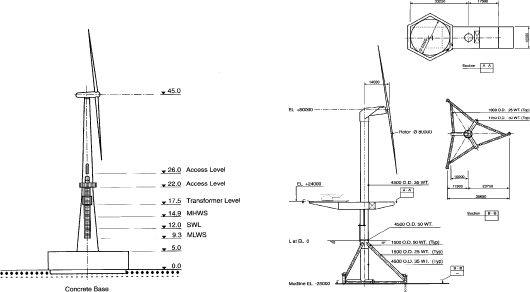
560 Wind Power Generation and Wind Turbine Design
structures found at sea. The design is not only dependent on turbine loads and
associated overturning moment, the wave and currents add signifi cant loads too.
For the design of these structures wind, wave and current loads need to be assessed
as acting on the offshore wind turbine system as a whole.
The development of offshore wind began in the 1970s and 1980s with studies
and assessment of the potential wind resource offshore. In the 1990s several pilot
offshore wind farms were constructed in the European waters, which helped
develop knowledge and new technology. In 2002, the fi rst large offshore wind
farm Horns Rev was constructed in the North Sea off the Danish coast: 80 turbines
with an installed capacity of 160 MW. In the years that followed, other countries
followed with the construction of these large, commercial offshore wind farms.
The EU target for 2020 is to have 40 GW of installed capacity.
2 H istory of offshore, wind and offshore wind development
of offshore structures
2.1 The origin of “integrated design” in offshore wind energy
During the 1970s, 1980s and early 1990s, a number of studies were conducted in
the fi eld of offshore wind energy. Offshore and shipbuilding as well as renewable
energy groups drafted reports on how to effectively harness the offshore wind
energy potential. The fi rst designs were mainly based on the multi-megawatt pro-
totype turbines built in the 1970s: 3 MW and more. The structures were large,
heavy and stiff: based on the accumulated experience of offshore construction in
the North Sea for oil & gas exploitation. Figure 1 shows examples of a design from
the British RES study and a Heerema tripod design [ 1 , 2 ].
The design did incorporate combined wind and wave loading, but only on a basic
level for extreme load case calculations. The stiffness of the structure prevented
heavy dynamic response, so fatigue was not a big issue. For the subject operation
and maintenance a direct copy of offshore platforms was made: the addition of a
complete helicopter deck.
Figure 1 : Offshore wind turbine design from the RES and the Heerema study.
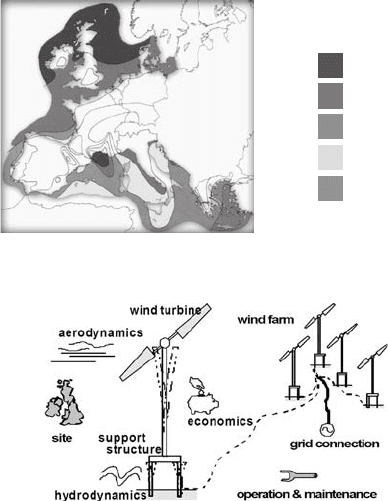
Design of Support Structures for Offshore Wind Turbines 561
In 1995 the Joule I “Study of Offshore Wind Energy in the EC” was published [ 3 ].
The study gave an overview of the wind potential offshore as shown in Fig. 2 . The
study described the design of offshore wind turbines in a more generic way with
example designs for different types of offshore wind turbines. It was found that for
one turbine wave loads could be dominant while for the other wind was the domi-
nant load source. One of the main issues found was the benefi t of aerodynamic
damping on the dynamic behaviour of the structure when the turbine is in opera-
tion. It was also stated that a softer support structure would further enhance the
aerodynamic damping effect, but at the cost of increased tower motion.
The Joule III Opti-OWECS [ 1 ] report fi nally made a complete design focusing
on the integrated dynamic features of fl exible offshore wind turbines. The design
incorporated the entire offshore wind farm with all its features from turbines to oper-
ation and maintenance philosophy to cost modelling. Figure 3 gives an overview
of all subjects covered in this integrated design scheme.
The Opti-OWECS study further explored the possibilities of fl exible dynamic
design. Although several types of support structures were reviewed, it was decided
to make a full design of a soft monopile structure to benefi t in full from the aero-
dynamic damping and assess the potential negative consequences of large struc-
tural motion. It was found that a structure could be designed with a natural
frequency below both the rotation and the blade passing frequency of the turbine,
a so-called soft–soft structure. The frequency distributions are shown in Fig. 4 .
> 10 m/s
8.5-10 m/s
7.5-8.5 m/s
6.0-7.5 m/s
<6.0 m/s
Figure 2 : Yearly average wind speed at 100 m height for the European Seas.
Figure 3: Subjects covered in the integrated design approach of the Opti-OWECS
study.
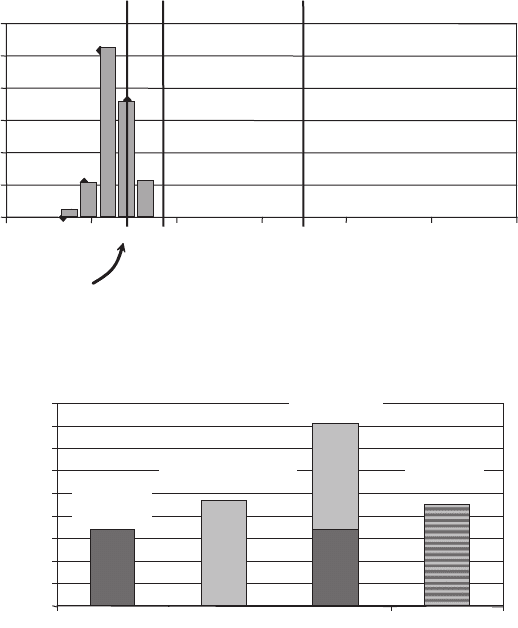
562 Wind Power Generation and Wind Turbine Design
The fact that the structure’s natural frequency coincided with a large portion of
wave frequencies was further investigated. The aerodynamic damping of the tur-
bine was found to reduce fatigue signifi cantly, doubling the structures fatigue life
when taken into account. To enable the analysis of this feature, full non-linear time
domain simulations were found to be necessary of simultaneous wind and wave
loading. Should wind and wave loads be analysed separately, the effect will not
become visible by just adding the separate analyses as can be seen in Fig. 5 .
Next to the detailed investigation of the dynamic behaviour in the design, a large
number of practical issues were addressed in an integrated way. For installation
it was found that onshore pre-installation would cause large cost reductions.
For the correction of misalignment of the driven foundation pile, a transition piece
was proposed. Installation of fully operational turbines and the misalignment
correction are shown in Fig. 6 . It was concluded that large-scale offshore wind
occurrence of wave frequency per year
0%
10%
20%
30%
40%
50%
60%
0 0.2 0.4 0.6 0.8 1 1.2
Frequency [Hz]
2
P
1
P
Support structure’s
natural frequency
Figure 4 : Rotation (1P) and blade passing frequency (2P) of the Opti-OWECS
turbine with the structure’s natural frequency and a histogram of the
occurring wave frequencies.
0
5
10
15
20
25
30
35
40
45
equivalent bending moment [MNm]
offshore technology
design tool
integrated
design tool
superposition
wind turbine
design tool
pure wind wind & waveswind + waveswave no aero.
damp.
Figure 5 : Comparison of fatigue calculations for wind only, wave only, wind and
wave combines from separate and simultaneous analyses.
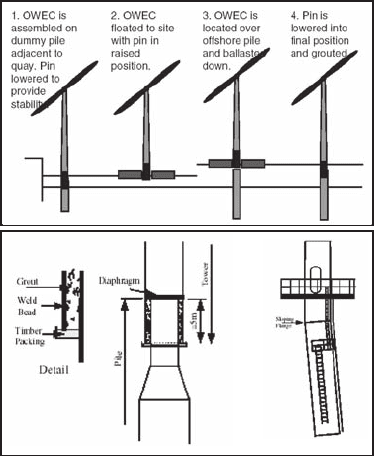
Design of Support Structures for Offshore Wind Turbines 563
energy application would require purpose-built vessels because existing vessel
were either too large (offshore cranes) or too small.
2.2 From theory to practice: Horns Rev
The installation of Horns Rev in 2002 was the largest practical test of all theoreti-
cal fi ndings. The installation of the foundation pile was done on a rather traditional
manner: a small jack-up with a crane. For the installation of the turbines however
two ships were entirely converted to purpose-built turbine installation vessels.
Choosing a normal ship would ensure high sailing speed from and to port. A jack-
ing system was added which only pre-stressed the legs without lifting the entire
vessel out of the water. Two blades were already connected to the nacelle before
placing it on the deck of the installation vessel. The method was christened “bunny
ears” for obvious reasons. The installation of the tower and turbine was reduced to
four lifts; two tower sections, nacelle with two blades and the fi nal blade.
All appurtenances were pre-fi tted in port to the transition piece: boat landing,
J-tube, platform and the transition piece was grouted to the foundation pile.
Figure 7 shows the “bunny ears”, the A2Sea installation vessel, the transition piece
being pre-fi tted with a J-tube and the installation of the transition piece.
The design for the support structures on Horns Rev was fully covered by the
owner of the wind farm: Elsam supplied all contractors with a complete pre-design,
which was to be prized and for which an installation method was to be drafted.
Figure 6 : Installation of fully operational turbine and connection details between
foundation pile and tower with misalignment correction.
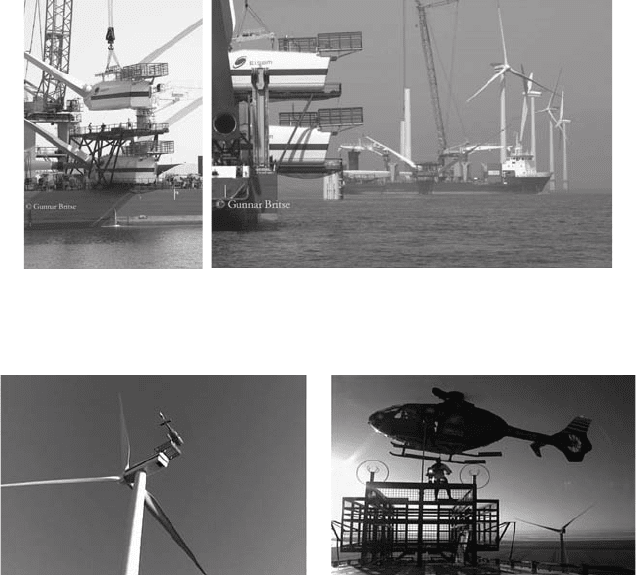
564 Wind Power Generation and Wind Turbine Design
The design was well documented and integrated. The contractors were also invited
to give their own alternative design. The amount of information for this part however
was much less: the support structure was to end at 9 m above the mean sea level and
the only interaction from the turbine was a static load and moment at this 9 m level.
This did not improve integrated design but it can be argued that no contractor at that
time would have any time for more detailed integrated turbine–foundation interaction
analysis as all engineering went into “getting the things there”.
For maintenance all nacelles are equipped with a heli-hoist platform onto which
mechanics can be lowered even when boat access is not possible due to high waves
(see Fig. 8 ).
The Horns Rev project proved that many practical issues addressed in the paper
studies were applicable in real offshore wind. The amount of overall integration,
or even the need for it is not crystal clear: many individual optimisations could be
done without affecting the entire system.
2.3 Theory behind practice
The installation of the two turbines offshore of Blyth in the UK was part of a large
EU-funded project to study Offshore Wind Turbines at Exposed Sites (OWTES).
Figure 7: Bunny ears, the pre-fi tting of two blades, purpose-converted installation
vessels, pre-fi tting of J-tube to the transition piece and the installation
of the transition piece.
Figure 8: Heli-hoist platforms are installed on turbines to lower mechanics for
maintenance.
